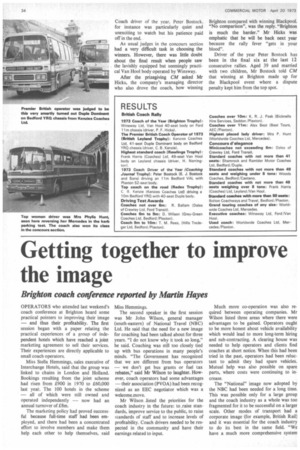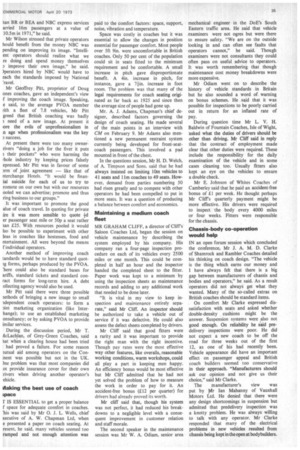Getting together to improve the image
Page 36

Page 37

If you've noticed an error in this article please click here to report it so we can fix it.
Brighton coach conference reported by Martin Hayes
OPERATORS who attended last weekend's coach conference at Brighton heard some practical pointers to improving their image — and thus their profitability. The first session began with a paper relating the practical experiences of a group of independent hotels which have reached a joint marketing agreement to sell their services. Their experiences are directly applicable to small coach operators.
Miss Stella Hemmings, sales executive of Interchange Hotels, said that the group was linked to chains in London and Holland. Bookings resulting from the joint scheme had risen from £900 in 1970 to £60,000 last year. The 100 hotels in the scheme — all of which were still owned and operated independently — now had an annual turnover of £8m.
The marketing policy had proved successful because full-time staff had been employed, and there had been a concentrated effort to involve members and make them help each other to help themselves, said Miss Hemmings.
The second speaker in the first session was Mr John Wilson, general manager (south-eastern) of National Travel (NBC) Ltd. He said that the need for a new image for coaching had been talked about for three years. "I do not know why it took so long," he said. Coaching was still too closely tied up with bus operations in many people's minds. "The Government has recognized that we are different from bus operators — we don't get bus grants or fuel tax rebates," said Mr Wilson to laughter. However, coach operators had some advantages — their association (PVOA) had been recognized as an EEC negotiator which was a welcome,xnove.
Mr Wilson -listed the priorities for the coach industry in the future: to_raise standards, improve service to the public, to raise standards of staff and to increase levels of profitability. Coach drivers needed to be respected in the community and have their earnings related to input. Much more co-operation was also required between operating companies. Mr Wilson listed three areas where there were advantages to be gained. Operators ought to be more honest about vehicle availability which would lead to more long-term hiring and sub-contracting. A clearing house was needed to help operators and clients find coaches at short notice. When this had been tried in the past, operators had been reluctant to admit they had spare vehicles. Mutual help was also possible on spare parts, where costs were continuing to increase.
The "National" image now adopted by the NBC had been needed for a long time. This was possible only for a large group and the coach industry as a whole was too fragmented for it to be successful on a larger scale. Other modes of transport had a corporate image (for example, British Rail) and it was essential for the coach industry to do its best in the same field. "We have a much more comprehensive system an BR or BEA and NBC express services arried 16m passengers at a value of 10.5m in 1971," he said.
Mr Wilson stressed that private operators hould benefit from the money NBC was pending on improving its image. "Intellient operators should realize what we re doing and spend money themselves 3 improve their own image," he said. )perators hired by NBC would have to each the standards imposed by National 'ravel.
Mr Geoffrey, Pitt, proprietor of Doug ones coaches, gave an independent's view I improving the coach image. Speaking, e said, to the average PVOA member rith a fleet of 7.8 vehicles, Mr Pitt greed that British coaching was badly 3 need of a new image. At present it ore the evils of =professionalism in n age when professionalism was the key 3 success.
At present there were too many ownerrivers "doing a job for the flyer it puts their pockets" who were harming the hole industry by keeping prices falsely epressed. Mr Pitt was in favour of some 3rm of joint agreement — like that of nterchange Hotels. "It would be finanial suicide for each of us to try to romote on our own but with our resources °Wed we can advertise; promote and thus ring business to our groups."
It was important to promote the good alue of coach travel. In quoting for private ire it was more sensible to quote er passenger seat mile or 50p a seat rather 'Ian £25. With resources pooled it would !so be possible to experiment with other leas in coaches like hostesses, food and ntertainment. All were beyond the means f individual operators.
Another method of improving coach tandards would be to have standard quotig forms, perhaps produced by the PVOA. 'here could also be standard bases for ariffs, standard tickets and standard conrant forms for long-term hire. A debt °Reefing agency would also be used.
Mr Pitt said there were three possible nethods of bringing a new image to small Idependent coach operators: to form a 3int marketing organization (like Interhange); to use an established marketing onsultancy; or by asking PVOA to provide imilar services.
During the discussion period, Mr T. 4cLachlan, of Grey-Green Coaches, said at when a clearing house had been tried had proved a failure. For some reason autual aid among operators on the Connent was possible but not in the UK. )ne problem was that most cornpanies did ot provide insurance cover for their own rivers when driving another operator's chicle.
Illaking the best use of coach ;pace
▪ IS ESSENTIAL to get a proper balance f space for adequate comfort in coaches. his was said by Mr 0. J. L. Wells, chief xecutive of A. W. Chapman Ltd, when e presented a paper on coach seating. At resent. he said, many vehicles seemed too ramped and not enough attention was paid to the comfort factors: space, support, noise, vibration and temperature.
Space was costly in coaches but it was essential to allow the changes in position essential for passenger comfort. Most people over 5ft 9in. were uncomfortable in British coaches. Only 50 per cent of the population could sit in seats fitted to the minimum requirement and be comfortable. A small increase in pitch gave disproportionate benefit. A 4in. increase in pitch, for instance, gave a 7-fin. increase in foot room. The problem was that many of the legal requirements for coach seating originated as far back as 1925 and since then the average size of people had gone up.
Mr. A. J. Adams, Chapman's chief designer, described factors governing the design of coach seating. He made several of the main points in an interview with CM on February 9. Mr Adams also mentioned a new permanent restraint system currently being developed for front-seatcoach passengers. This involved a pad mounted in front of the chest.
In the questions session, Mr H. D. Welch, of A. Timpson and Sons. said that he had always insisted on limiting 10m vehicles to 41 seats and Ilm coaches to 49 seats. However, demand from parties numbering 50 had risen greatly and to compete with other operators he had been compelled to put in more seats. It was a question of producing a balance between comfort and economics.
Maintaining a medium coach fleet MR GRAHAM CLIFF, a director of Cliff's Saloon Coaches Ltd, began the session on vehicle maintenance by describing the system employed by his company. His company ran a four-page inspection procedure on each of its vehicles every 2500 miles or one month. This could be completed in half an hour and the inspector handed the completed sheet to the fitter. Paper work was kept to a minimum by using the inspection sheets as maintenance records and adding to any additional work that needed to be done later.
"It is vital in my view to keep inspection and maintenance entirely separate," said Mr Cliff. An inspector should be authorized to take a vehicle out of service if it was defective. He could also assess the defect sheets completed by drivers.
Mr Cliff said that good fitters were a rarity and it was important to provide the right man with the right incentive. Though pay rates were the most effective way other features, like overalls, reasonable working conditions, warm workshops, could all play a part in keeping men happy. An efficiency bonus would be most effective but Mr Cliff admitted that he had not yet solved the problem of how to measure the work in order to pay for it. An accident-free bonus (£12 per quarter) for drivers had already proved its worth.
Mr cliff said that, though his system was not perfect, it had reduced his breakdowns to a negligible level with a consequent improvement in customer relation and staff morale.
The second speaker in the maintenance session was Mr W. A. Odiam, senior area mechanical engineer in the DoE's South Eastern traffic area. He said that vehicle . examiners were not ogres but were there to ensure safety. "We are on the outside looking in and can often see faults that operators cannot," he said. Though examiners were not consultants they could often pass on useful advice to operators. It was worth remembering that though maintenance cost money breakdowns were more expensive.
Mr Odiam went on to describe the history of vehicle standards in Britain but he also sounded a word of warning on bonus schemes. He said that it was possible for inspections to be poorly carried out in return for an inflated rate of pay.
During question time Mr L. V. H. Baldwin of Fountain Coaches, Isle of Wight, 'asked what the duties of drivers should be other than driving. Mr Cliff said in reply that the contract of employment made clear that other duties were required. These include the responsibility for the daily examination of the vehicle and in some cases cleaning too. Usually fitters also kept an eye on the vehicles to ensure a double check.
Mr E. Johnson of Whites Coaches of Camberley said that he paid an accident-free bonus of 1 per week. He thought perhaps Mr Cliff's quarterly payment might be more effective. His drivers were required to inspect the body every 4000 miles or four weeks. Fitters were responsible for the chassis.
Chassis-body co-operation would help IN an open forum session Which concluded the conference, Mr J. A. M. D. Clarke of Shamrock and Rambler Coaches detailed his thinking on coach design. "The vehicle is the thing which earns our money and I have always felt that there is a big gap between manufacturers of chassis and bodies and operators," he said. As a result operators did not always get what they wanted. Many of the so-called extras on British coaches should be standard items.
On comfort Mr Clarke expressed dissatisfaction with seats and asked whether double-density cushions might be the answer. Suspension systems were also not good enough. On reliability he said predelivery inspections were poor. He did not expect a new coach to be off the road for three weeks out of the first 12, as one of his had recently been. Vehicle appearance did have an important effect on passenger appeal and British coach builders seemed too conservative in their approach. "Manufacturers should ask our opinion and not give us their choice," said Mr Clarke.
The manufacturer's view was put by Mr Ian Mahanny of Vauxhall Motors Ltd. He denied that there were any design shortcomings in suspension but admitted that predefivery inspection was a knotty problem. He was always willing to talk with any operator. Mr Clarke responded that many of the electrical problems in new vehicles resulted from chassis being kept in the open at bodybuilders.




































































































